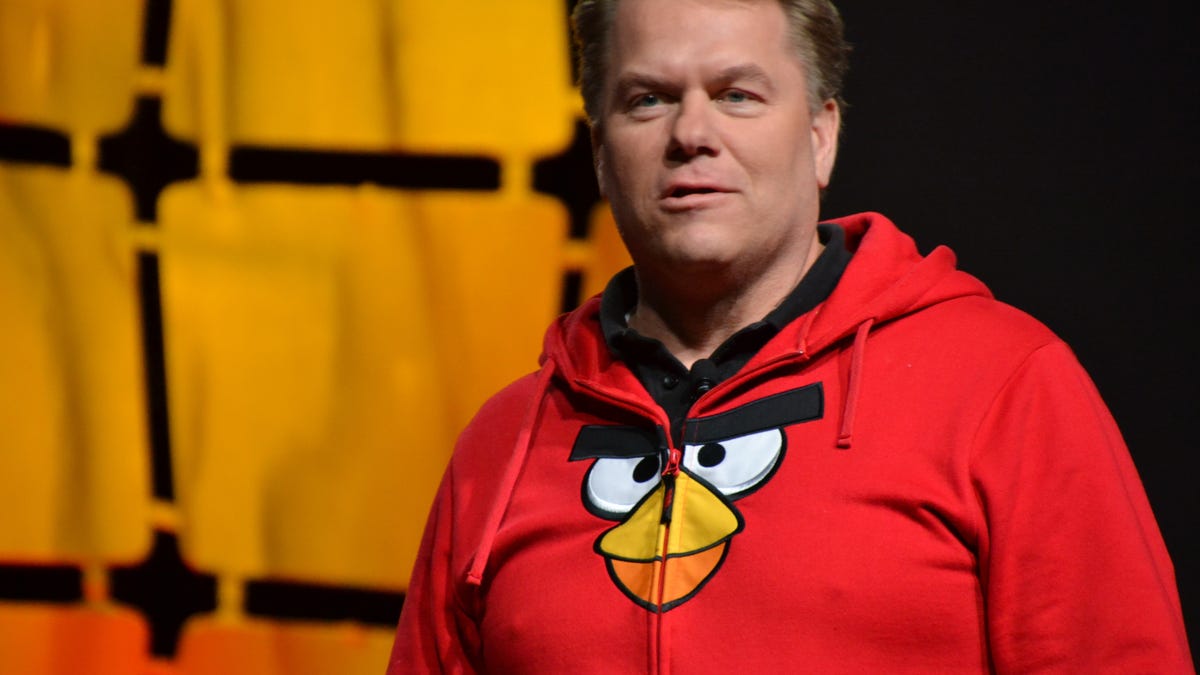Angry Birds creator Rovio: We're an 'entertainment' company
At the CTIA 2013 trade show, Rovio's chief operating officer says "gaming company" no longer fits the bill.

LAS VEGAS -- Rovio, the company that developed the popular Angry Birds games, is not just a mobile gaming company anymore. It's an "entertainment" company, says Chief Operating Officer Harri Koponen.
Speaking at the CTIA 2013 trade show here Wednesday, Koponen described the company's evolution from casual game-maker to media mogul. The company, which launched its first Angry Birds game in December 2009 on the iOS platform, has built an empire around the lovable, wingless Angry Birds, which players hurl at structures to protect their eggs from "bad piggies."
"Entertainment is a big part of our business," Koponen said. "We're not just a games company anymore. It's all about evoking emotions and getting our fans emotionally connected to the story."
The idea is that through the vast merchandising relationships the company has with licensees around the globe, plus the animated cartoons it's developing to tell the back story of why these birds are so angry, the company hopes to create a fan base that will be loyal to the characters and ultimately consume more games.
The games themselves haven't diminished in importance, Koponen added. The company still makes 60 percent of its revenue from games. It makes about 40 percent from the merchandising. But the merchandising, and now the new cartoons, help to keep those games alive in the market and to drive downloads.
Indeed, Angry Birds remains one of the most popular and recognizable mobile gaming brands on the planet. The company claims that variations of its game have been downloaded more than 1.7 billion times over the past three and a half years.
How did the Finnish game developer manage to create such lasting appeal for the game? Koponen said it's important to maintain the quality and the frequency of new game releases. For example, last year it released Angry Birds in Space, which skyrocketed to the top of the gaming charts with 10 million downloads in just three days. Later in the year it teamed up with another merchandising giant, George Lucas, to launch Angry Birds Star Wars, which was another record-breaking hit that shot to the No. 1 position in Apple's U.S. app store in the first half hour it was available.
"We have tried to make sure fans always get something new," Koponen said. "And we always give updates for free. (The goal is) to make sure fans are happy. And we don't penalize them ever."
But the real key to Rovio's success with Angry Birds seems to be the extensive licensing deals it has struck. It now has 500 licensees around the globe, selling everything from Angry Birds stuffed dolls to Angry Birds board games and Angry Birds hoodies, like the one that Koponen sported for his keynote address.
Most recently the company began creating animated cartoons to help drive the story of the Angry Birds and their rivals, the Bad Piggies. All of this is part of a strategy to keep the Angry Birds brand alive and to create a following of devoted disciples, much like American sports fans who spend billions of dollars each year on clothing and other accessories advertising their favorite teams' logos, Koponen said.
"You need to have fans," he said. "Every single person recognizes the brand of Angry Birds. We are still the No. 1 game around the world."
The company's ability to remain at the top is a massive accomplishment. The mobile games business is a tough one, considering the average life cycle of a game in a mobile app store is about two weeks, Koponen said.
"This is one of the toughest businesses today," he said. "You either break it or make it in a matter of 10 to 14 days."
Koponen said it's easy to become a victim of one's success. But he said that's why the company is venturing into other mediums, such as the cartoons. It's an effort to continue telling the story in an easy and entertaining way. But he also emphasized the need to ensure that the quality of the "product" it sells is still very high.
"The whole experience needs to be fun," he said. "And telling the best story is essential. It's not enough just to do some animation. We have to pay attention to the details."

